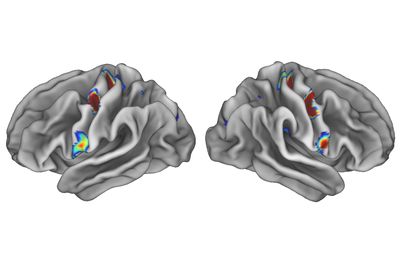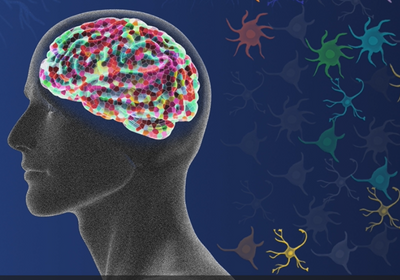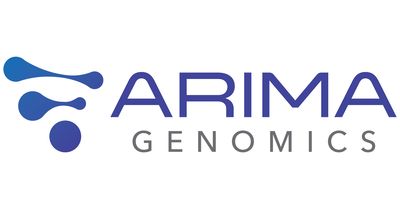ABOVE: Evan Gordon/Washington University
Even before speaking in front of a large crowd, your palms may start to sweat, your heart may race, and your shoulders may tense up.
Little is known about why this happens, and how mental states, like emotions, influence the body in anticipation of an event. Now, however, researchers have identified a previously undiscovered brain network that might be behind this mind-body connection, according to new research published today (April 19) in Nature.
The newly discovered network involves both the motor cortex and cognitive areas of the brain, upending a long-held view that the motor cortex is only involved in producing movements.
“The study is very interesting, very exciting,” says Michael Graziano, a neuroscientist at Princeton who was not involved in the study.
See “The Cerebellum’s Functions in Cognition, Emotion, and More”
The primary motor cortex sits in the back of the frontal lobes, near the temple. The dominant paradigm states that the motor cortex is simplistic. Planning, cognition, and conscious initiation of movements happen elsewhere in the brain; the motor cortex just receives these signals, relaying them directly to muscles.
The motor cortex is organized in a way that correlates to a distorted representation of the human body called the cortical homunculus, where greater areas of the cortex are dedicated to parts of the body capable of fine motor control. This map is organized in an orderly fashion: the upper part of the cortex controls the toes, while the lower part, near the ear, controls the head. Study coauthor Evan Gordon explains that the homunculus is one of the most entrenched ideas in cortical neuroscience. “It’s one of the first things you learn about in grad school,” he says.
“This map goes all the way [back] to 1870,” says Graziano, who studied the motor cortex for more than a decade. “We’re 150 years on from the discovery of this motor map. And it’s very traditional . . . and embedded.”
“It’s also not true.”
Gordon and Nico Dosenbach, both neuroscientists at Washington University School of Medicine in St. Louis, didn’t set out to discover a new brain network or to challenge the idea of a cortical homunculus. Gordon studies the brain using a method called precision fMRI, which involves scanning the brain of the same person over and over again to eventually, as the name implies, arrive at extremely precise readings. The technique “squeezes the noise out of the data,” Gordon says, by averaging a lot of data from one person instead of averaging across multiple people, as is often the case in fMRI studies. Gordon only recently turned his attention to the motor cortex, expecting to find maps of the body easily.
In their search for the homunculus, Gordon and Dosenbach scanned the brains of seven participants, either while they were at rest or while they performed movements, such as winking or bending their knees.
As they scanned participants, the researchers began to see the same strange results again and again. “We kept seeing these three different regions in the primary motor cortex that were very strongly connected to each other within one hemisphere,” Gordon explains. “Honestly, we kind of ignored it for a while.”
But they kept seeing the strange regions. And eventually, they decided to look into the phenomenon. “It’s really easy when you do these kinds of experiments to see things that don't quite make sense in the traditional view and to assume it’s just noise,” says Graziano.
While some regions of the motor cortex were activated when participants moved just one body part, a finding that suggests they’re directly linked to that movement or body part, these strange cortical regions fired in response to coordinated movements of several body parts simultaneously—breaking from the idea of the homunculus.
The team went on to analyze three large, publicly available fMRI datasets containing data from 50,000 people: the Human Connectome Project, the Adolescent Brain Cognitive Development Study, and the UK Biobank. All of the datasets showed the same thing: three interconnected areas in the motor cortex that weren’t mapped to just one body part.
From this data, the researchers mined connectivity information in search of brain areas with coordinated activity, which could indicate that the areas were part of the same network. They found that the three newly discovered areas of the primary motor cortex connected to the cingulo-opercular network (CON), a brain region that’s been linked to action, goals, arousal, and pain. “We’ve thought about this network as one of the smartest networks in the brain because it does your high-level planning,” explains Gordon. The network also involved several other motor and sensory areas of the brain. Overall, they called this network the somato-cognitive action network, or SCAN, hypothesizing that the network connects goals, physiology, and body movement.
See “Speech Decoded from Brain Activity in Area for Hand Control”
While SCAN activity was also present in the larger datasets, Gordon suspects that the result had been there the whole time, but they and others had just dismissed the findings.
The researchers found a similar network in nonhuman primates, using fMRI data from macaques. In monkeys, the SCAN was also connected to brain areas that control things like heart rate and breathing, leading the researchers to conclude that one of the network’s duties might be to put the body on alert in response to a stimulus, such as a stressful event.
While connections between brain areas that control autonomic functions and the SCAN haven’t been found in humans, Gordon says that in the future, he’d like to dig into the connection between the SCAN and physiological changes in response to anxiety or stress, especially in individuals with anxiety disorders.
It’s difficult to assign a clear function to the network because fMRI data can only establish a correlation between behavior and brain activity, the researchers caution, but they add that there's a lot to be gleaned from these types of datasets. “I think that we’re still sort of working our way through what this means. But this really revolutionized our idea of how the brain helps you plan and execute actions,” says Gordon.






